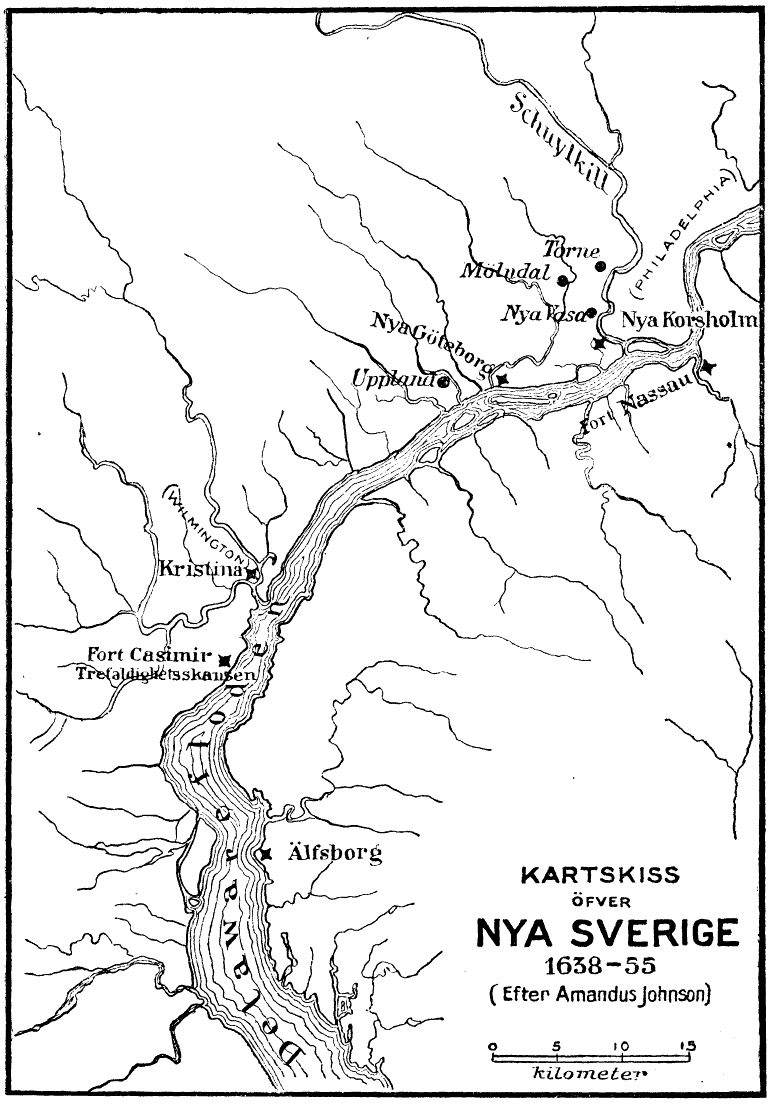The New Sweden colony first made an appearance in Twelve Mile Circle a few weeks ago. Back then I spoke of an ancient trust, on Burlington Island in the Delaware River.
Swedes don’t get much attention for their colonial history in North America. The narrative generally focuses upon English, Spanish and French interests. Sometimes Dutch efforts gain a mention because of New Netherland, probably because their capital at New Amsterdam later became New York City under British control. However Sweden’s colonial aspirations hardly generate more than a footnote when mentioned at all.

Sweden transformed into a significant European power during the 17th Century: “By mid-century, the kingdom included part of Norway, all of Finland and stretched into Russia. Sweden’s control of portions of modern Poland, Latvia, Estonia, Lithuania and Germany made the Baltic Sea essentially a Swedish lake.” Meanwhile, colonization began to sort the first-tier powers from the runners-up. Sweden wanted to be a player. They had to reach across the ocean or risk being left behind.
Colonizing the New World
They formed the New Sweden Company and appointed Pieter Minuit to lead an effort to establish a colony. Although not Swedish, Minuit (a Walloon) understood the target area well. He’d already been credited with “purchasing” Manhattan from a local Lenape tribe of Native Americans for 60 guilders worth of trinkets and beads, and he’d led the New Netherland colony for several years thereafter. He had the requisite experience and he was available. The Dutch government later recalled him and essentially fired him “presumably for granting privileges to the patroons at the expense of the Dutch West India Company.”
Minuit understood that the Dutch were in no position to defend their southern boundaries in New Netherland. He sailed a Swedish expedition directly into Delaware Bay and up to where it narrowed to form the Delaware River. Here he took the expedition up to its confluence with a smaller river and built a fortification at a strategic point, naming it Fort Christina in honor of the Swedish queen. He contrived another “purchase” from the local Native Americans in an attempt to legitimize this Swedish incursion upon Dutch claims. New Sweden (Nya Sverige) was born in 1638 at what is now modern-day Wilmington, Delaware.
The Heyday
The colony prospered initially, especially under Governor Printz during a decade of expansion between 1643 and 1653. I’ve attempted to draw an approximate area of maximum influence. Sweden claimed a much larger area than this, however it stuck primarily to the waterways of the Delaware and Schuylkill Rivers, and various nearby tributaries.
Consider a modern-day area extending south of Wilmington to northeast of Philadelphia with a concentration right around Philadelphia International Airport and that should do it. This included territory in what would later become the Twelve Mile Circle (the real one!). It never covered much territory and it didn’t extend far inland. Neither did it last very long. The party ended by 1655 although it sputtered-along for awhile afterwards under other nations’ control.
1655 marked the year that the Dutch took back what they felt rightfully belonged to them. They captured the Swedish colony and incorporated it within New Netherland. They allowed the Swedes to exercise a level of autonomy with little change to day-to-day affairs. Next came the English who overthrew New Netherland in 1664, followed again by the Dutch who gained an upper-hand in 1673 and finally by the English for the last time in 1674. Swedish autonomy continued unofficially for awhile until William Penn secured a charter for Pennsylvania in 1682 and assimilation began.
Remnants
Only small artifacts remain of the failed Swedish attempt to colonize North America. One tangible element includes the C. A. Nothnagle Log House which dates to circa 1638, from the earliest days of New Sweden. The original cabin is the smaller part of the structure on this Google Street View image.
This simple cabin in Gibbstown, New Jersey is reputed to be “one of the oldest surviving log houses in the United States.” It may have been constructed either by Swedes or by Finnish settlers who were part of the Swedish Empire at the time.
Other features offering hints and clues of New Sweden include towns such as Swedesboro, NJ (map) and Christiana, DE (note slight spelling variation; map); the Christina River through northern Delaware (map); parks in Wilmington, DE (map) and Tinicum Township, PA (map); a handful of Old Swedes Churches plus any number of roads with heritage-themed names. The legacy also continues through groups such as the Swedish Colonial Society in Philadelphia, PA; and the New Sweden Colonial Farmstead Museum in Bridgeton, NJ (UPDATE: which unfortunately closed circa 2015).
Doubtless, few people realize the former Swedish presence along the lower Delaware River.

Leave a Reply